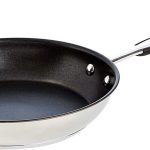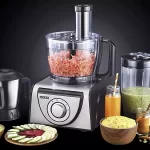How to keep raw meat in the fridge

Raw meat is one of those foods that a lot of people don’t really know how to handle.
We know that we must be careful with meat and the surfaces to which it is exposed. Some of us are disgusted by the idea of handling raw meat, while others just deal with it and never have a problem.
Handling raw meat requires care and caution. Raw meat is known to carry bacteria that can lead to food poisoning and illness. That’s why there are specific instructions for cooking most raw meat to a certain temperature before eating it.
How do you store raw meat in the fridge? We recommend using the bottom shelf to store raw meat so there is no chance of dripping juices reaching the food below. You should also consider using a plate or container to catch the juices from the raw meat.
Storing raw meat in the refrigerator is simple, but you have to know and take into account a few things.
In this guide, we will explain how to store raw meat in the fridge. We have some tips and topics to cover here so you can be safe and fully informed on the subject.
Read on to find out how to store raw meat in the fridge and much more.
Storing Raw Meat in the Fridge - Complete Guide
Storing raw meat should be easy, right? You buy it packaged at the butcher shop or a local supermarket and put it in the fridge until you are going to use it. What else is there to know?
Although the description here is a basic overview, there are other things to keep in mind.
To begin with, is there a certain way to store it or a specific place in the fridge? How long can raw meat be stored in the fridge? Is it okay for raw meat to be uncovered?
There are a lot of variables to take into account here and there are just a few good practices to keep in mind. You certainly don’t want to risk contaminating other foods in your fridge or getting food poisoning from improper handling of raw meat.
When storing raw meat in the fridge, whether you put fresh meat in it or put it in for defrosting, you should take a few small precautions to protect other foods in the fridge from contamination.
It’s best if you can make room for raw meat on the bottom shelf of the fridge.
If for any reason any juices were to leak out of the container, this would ensure that it did not drip down onto other food that you have stored in the fridge. You may have to clean the shelf, but there will be no risk of contamination.
The other thing to keep in mind is that it really is best if you can place the raw meat in a bowl or on a plate if it’s wrapped in butcher paper, especially if you’re defrosting meat.
It’s another way to contain those juices and prevent them from spreading.
A lot of raw meat comes in those styrofoam dish containers. You don’t need to put them in a bowl or on a plate if they have a slight edge. If the meat is just wrapped in butcher paper or something similar, you’ll need to use a container of some sort to hold the juices.
Why the bottom shelf of the fridge?
While there is nothing that says you have to store raw meat in a specific place, there are some storage tips. That raw meat could affect other items in the fridge if not stored carefully.
You’ve heard the word cross-contamination, and that’s what you’re trying to avoid when placing items like raw chicken, raw meat, fish, or other types of raw meat in your fridge.
You also don’t want that raw meat touching anything else or sharing its raw meat juices with anything else.
The best place to store meat to avoid potential cross contamination is at the bottom of your fridge. The bottom shelf works great for this purpose. We do not usually recommend the use of a drawer, unless your refrigerator has a special drawer for meat.
That bottom shelf will be the perfect spot! Just leave that spot open for raw meat and give it its own special location right there.
How long can you keep raw meat in the fridge?
There are different variations of raw meat. You can have chopped steak or hamburger or chicken or lamb. The list could be endless. Not all meats are exactly the same, but the general rule of thumb is up to 5 days.
Check this table for some details. We have also added a freezer storage to the table for reference.
| Type of meat | Fridge | Freezer |
| Beef (any cut) | 3-5 days | up to 12 months |
| Chicken/Poultry | 1-3 days | up to 12 months |
| Pork (any cut) | 3-5 days | up to 12 months |
| Fatty fish (salmon) | 1-2 days | up to 3 months |
| other shellfish | up to 3 days | up to 6 months |
As you can see, the shelf life of raw meat in the refrigerator varies depending on the type of meat it is.
Most shellfish are very limited in how long they can be kept. The recommended period for the largest of fatty fish and shellfish is a maximum of 3 days of refrigerated storage.
Shellfish tends to be more susceptible to breeding bacteria the longer it is stored. This is simply due to the item and the environment it came from.
When it comes to beef or pork, these time frames are relevant to almost any cut of meat. Whether it’s ground beef, steaks, roasts, or anything else within these types of meat, the timeframes remain mostly the same across the board.
Chicken and poultry-related foods, regardless of whether they are breasts, thighs, or another cut of chicken, also have a shorter lead time. Chicken and seafood are some of the foods most at risk of cross contamination.
How to make raw meat last longer in the fridge?
The first thing you should do is recheck the temperature of your fridge . Many of us take it for granted that the fridge is as cold as it should be.
If you store raw meat in the fridge, you really want the temperature inside the fridge to be between 38-40 degrees Fahrenheit.
This particular temperature slows the spread of bacteria that might be on your raw meat. Reduces the likelihood of cross contamination and keeps meat fresh for as long as possible.
While it won’t stop bacteria from spreading, it will slow their growth extremely and protect your food overall.
Some fridges have thermometers where you can check. You can also use a candy thermometer or glass kitchen thermometer to check the temperature.
To check without a built-in thermometer, try filling a glass with water and placing the thermometer in it. Leave the glass in the refrigerator for about 8 hours.
You can leave the thermometer in the glass or put the thermometer back in the glass that is in the fridge. If your fridge is not within the recommended range, adjust the fridge’s temperature to a safe zone, then try again.
Here are other tips for fridge storage:
- Open the refrigerator only when necessary to maintain the proper temperature.
- Routinely clean the fridge and disinfect surfaces.
- Use the bottom shelf and a bowl or plate.
- When the meat is in the fridge, plan to use it quickly or put it in the freezer.
Can raw meat be left uncovered in the fridge?
You should never leave meat uncovered in the fridge . Even when you bring it to room temperature, you’ll want to cover it somehow. Whether you decide to cover it with plastic wrap or a lid, it’s important that you cover it.
Remember that raw meat is a breeding ground for bacteria . The best way to protect it is to follow all security recommendations.
Don’t leave it out in the open, as it can not only grow bacteria, but you could also share it in the fridge.
As with most other items you keep in the fridge, leaving it out in the open is not a great idea.
Related questions
We hope you find this guide on how to store raw meat in the fridge a valuable resource. Take a look at our Q&A section for more details.
What are the risks of raw meat?
Bacteria like listeria, salmonella, E. coli, and campylobacter are some of the biggest risks associated with raw meat.
They can cause illness and food poisoning. That is why it is so important to properly handle raw meat, and to cook it sufficiently before eating it.
Can raw meat be left in the fridge overnight?
Of course. As long as you use it within a couple of days and store it properly, nothing should happen.
The best way to thaw frozen meat is to leave it in the fridge overnight anyway, so one way or another, you’ll probably have to leave raw meat in the fridge at some point.











